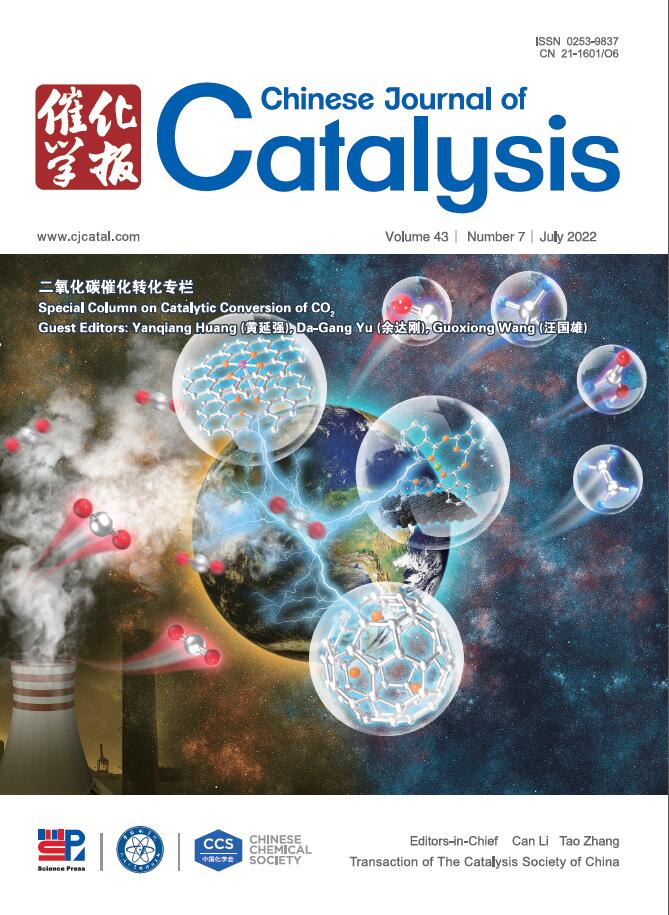The curvature structure unlocks an ultra-efficient metal-free carbon catalyst surpassing gold for acetylene hydrochlorination
IF 15.7
1区 化学
Q1 CHEMISTRY, APPLIED
引用次数: 0
Abstract
Metal-free carbon catalysts have garnered significant attention since their inception. Despite substantial advancements, including widely adopted strategies such as heteroatom doping and defect engineering, their catalytic performance remains inferior to that of metal-based catalysts. In this study, we have predicted and demonstrated that the curvature of carbon plays a pivotal role in the adsorption of acetylene and the overall catalytic performance. First-principles calculations suggest that a tip-enhanced local electric field at the defect site on the curved carbon catalyst enhances the reaction kinetics for acetylene hydrochlorination. The experimental results highlight the structural advantages of the curved defect site, revealing that high-curvature defective carbon (HCDC) demonstrates an adsorption capacity for acetylene that is almost two orders of magnitude higher than that of defective carbon. Notably, HCDC achieves an acetylene conversion of up to 90% at 220 °C under a gas hourly space velocity of 300 h–1, significantly surpassing the performance of the benchmark 0.25% Au/AC catalyst. This proof-of-concept study reveals the fundamental mechanisms driving the superior performance of carbon catalysts with curved nanostructures and presents a straightforward, environmentally friendly method for large-scale production of carbon materials with precisely controlled nanostructures. It highlights the potential for commercializing metal-free carbon catalysts in acetylene hydrochlorination and related heterogenous catalytic reactions.
曲率结构开启了一种超高效的无金属碳催化剂,超过了乙炔氢氯化的金
无金属碳催化剂自问世以来就备受关注。尽管有了很大的进步,包括广泛采用的策略,如杂原子掺杂和缺陷工程,但它们的催化性能仍然不如金属基催化剂。在这项研究中,我们预测并证明了碳的曲率在乙炔的吸附和整体催化性能中起着关键作用。第一性原理计算表明,在弯曲碳催化剂的缺陷部位,尖端增强的局部电场增强了乙炔加氢氯化反应动力学。实验结果表明,高曲率缺陷碳(HCDC)对乙炔的吸附能力比缺陷碳高出近两个数量级。值得注意的是,在220°C下,在300 h-1的气体每小时空速下,HCDC实现了高达90%的乙炔转化率,显著超过了基准0.25% Au/AC催化剂的性能。这项概念验证研究揭示了驱动具有弯曲纳米结构的碳催化剂优越性能的基本机制,并为具有精确控制纳米结构的碳材料的大规模生产提供了一种简单、环保的方法。它强调了在乙炔加氢氯化和相关的多相催化反应中实现无金属碳催化剂商业化的潜力。
本文章由计算机程序翻译,如有差异,请以英文原文为准。
求助全文
约1分钟内获得全文
求助全文
来源期刊

Chinese Journal of Catalysis
工程技术-工程:化工
CiteScore
25.80
自引率
10.30%
发文量
235
审稿时长
1.2 months
期刊介绍:
The journal covers a broad scope, encompassing new trends in catalysis for applications in energy production, environmental protection, and the preparation of materials, petroleum chemicals, and fine chemicals. It explores the scientific foundation for preparing and activating catalysts of commercial interest, emphasizing representative models.The focus includes spectroscopic methods for structural characterization, especially in situ techniques, as well as new theoretical methods with practical impact in catalysis and catalytic reactions.The journal delves into the relationship between homogeneous and heterogeneous catalysis and includes theoretical studies on the structure and reactivity of catalysts.Additionally, contributions on photocatalysis, biocatalysis, surface science, and catalysis-related chemical kinetics are welcomed.
 求助内容:
求助内容: 应助结果提醒方式:
应助结果提醒方式:


